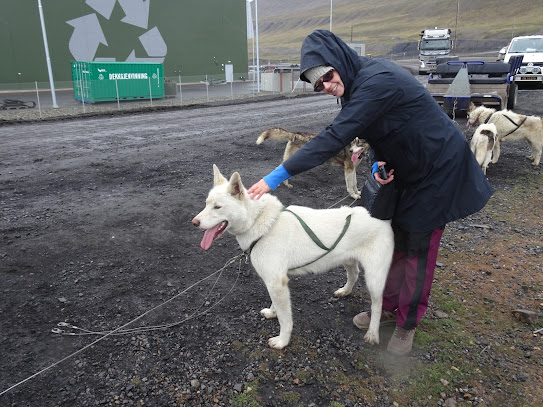We have been out of wi-fi range which is why we have not posted.
Svalbard basically means svalr ('cold') and barð ('edge', 'ridge', 'turf', 'beard'). The name Spitsbergen was used by Dutch explorer Wilhelm Barentz, who in 1596 described the "pointed mountains". This is on the same latitude as Northen Greenland, so it is in the High Arctic. Svalbard has permafrost and tundra.
It's the first time we can use our cold weather gear.
The German weather station on Svalbard during World War II saw the last Germans to surrender. On 4 September 1945, they were picked up by a Norwegian seal hunting vessel and surrendered to its captain.
Today we are off to see the huskies. Is that a sausage behind his back?
The Svalbard Global Seed Vault (concrete bunker on the left) preserves seeds from many of the world's crop varieties. Due to global warming of the permafrost it has started to sink so it may have to be replaced.
Transport is prohibited on bare ground, but snowmobiles are used extensively during winter.
There are also whales, dolphins walruses and polar bears. Polar bears are protected and people moving outside the settlements are required to have scare devices to ward off attacks. They are also advised to carry a firearm for use as a last resort. Svalbard has around 300 resident polar bears but shares with other locations 2,650 polar bears. The Svalbard reindeer is a distinct subspecies; although it was previously almost extinct, but it can be legally hunted (as can Arctic fox).
After lunch we had an included excursion to Camp Barentz which was a recreation of the Dutch explorer's hut. You cannot go past this point without an armed guide. You can see a glacier in the background.
Now you know what the dog Tuborg is looking at. He is probably a Greenlander mixed breed. These are bigger dogs so he would have trouble squeezing into his box. We assume the boxes are off the ground because of winter snow.
The Japanese armed guard is in the centre giving his safety briefing about polar bears.
"Form a human shield around me while I get help."















No comments:
Post a Comment